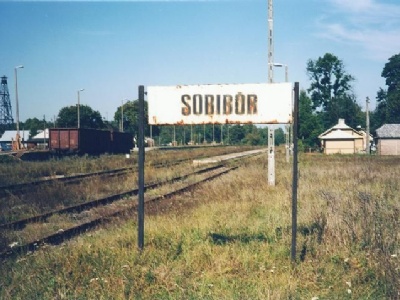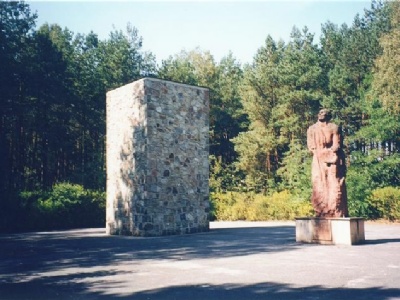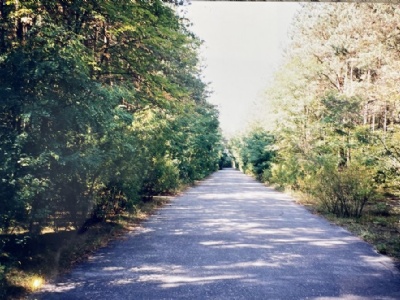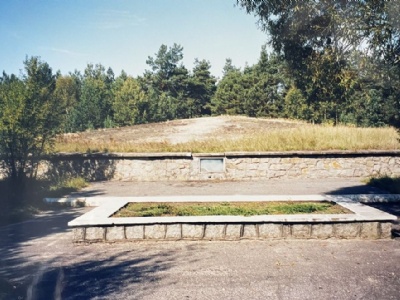Sobibor was the second camp of Operation Reinhardt to open and is located about 80 kilometres east of Lublin right on the border with Ukraine. Sobibor was set up specifically as a extermination camp and was located in an area surrounded by several other camps and its real purpose could therefore partly be camouflaged. Construction of the camp began in March 1942 in a sparsely populated wooded area adjacent to the Chelm-Wlodawa railway line, and was intended primarily to exterminate Jews from Lublin district and eastern Galicia. The extermination camp was not located in the village of Sobibor, but built about twelve kilometers south of Sobibor in a small place called Stare Kolonia Sobibor. Like the other two Operation Reinhardt camps (Belzec and Treblinka), it was divided into three areas. Camp I consisted of the prisoners’ barracks and kitchen. Camp II was adjacent to the station and where the Jews undressed, handed over their luggage and valuables. When a new transport of Jews arrived at the station, they were received by camp prisoners, an SS officer, who was, dressed in a white coat to give the impression of being a doctor. This fake doctor then gave a speech in which he told the newly arrived they would soon be able to come to a better place and settle down with their families. He assured that Sobibor was just a station on the way. While waiting for further transport they were asked for hygienic reasons to be deloused. After delousing they would be given food and assigned to easier work. After the speech they were told to proceed to camp II.
In camp II the daily work in the murder process was done and it was here the Jews were deceived. Prisoners were asked to undress and hand over their personal belongings. The belongings were then stored in storage buildings in Camp II. In camp II administration was located where approximately 30 SS officers worked and controlled everything. In addition to these 30 SS officers, about 100 Ukrainian served as camp guards These, like other guards within Operation Reinhardt, had undegone special training at Trawniki camp, outside Lublin. From camp II there was a camouflaged road, about 150 metres long to camp III. Among camp prisoners this road was called the celestial road or the tube and went to the gas chambers. Shortly before the gas chambers there was a building where women had their hair cut off by prisoners who had worked as hairdressers in the civilian life. The Jews were then forced into the gas chambers and killed by carbon monoxide, or engine exhausts, produced by a tank motor adjacent to the gas chambers. When the Jews were dead, the gas chambers were emptied of prisoners working in camp III. The bodies were searched for valuables, gold teeth were removed and the bodies were buried in large mass graves.
On the other side of the station platform was the commandant’s villa. A post first held by Franz Stangl before he was transferred to Treblinka in late August 1942. The new commandant of Sobibor became, SS-Hauptsturmführer Franz Reichleitner. Like his predecessor, he was also from Austria, and as Stangl had served at the euthanasia centre in Hartheim before being transferred to Poland and Operation Reinhardt. According to witnesses, Reichleitner was rarely in the camp and when he was, he was usually drunk. The SS officer best known from Sobibor is SS-Oberscharführer Gustav Wagner, also a veteran from Hartheim. Wagner was nicknamed Welfel (wolf) because of his brutality and temper. Wagner could shoot prisoners for the smallest trifle. When an escape attempt failed, he did not only murder those who tried to escape. He also appointed some fifty, who in turn had to appoint another prisoner to be executed. If they refused to appoint someone, Wagner threatened to execute all prisoners. After the war, he fled to Brazil but was tracked down in 1978 by the famous ”Nazi hunter” Simon Wiesenthal (1908 – 2005) and was demanded extradition by both West Germany and Israel. But because Brazil had no extradition treaty with either West Germany or Israel, he was never extradited. In 1980 he committed suicide under unclear circumstances.
During Sobibor’s first phase between May and July 1942, there were three gas chambers measuring 16 square meters each, however, as in the case of Belzec, bottlenecks arose when the capacity of the gas chambers was not sufficient in relation to the number of transports arriving in Sobibor. Therefore, three new gas chambers of equal size were built next to the three old ones with a corridor between them. Between 200 and 300 prisoners then worked to empty the gas chambers and prepare them for new victims by flushing away excrements from both floors and walls. In connection with the construction of the three new gas chambers, repairs were also carried out on the railway line between Chelm and Wlodawa before the murder process was resumed in October 1942. Although Sobibor, like Belzec and Treblinka, was set up to exterminate Jews in General Government, Sobibor received Jews from western Europe. Mainly dutch Jews were murdered in Sobibor alongside polish jews. Out of the 100,000 Dutch Jews murdered by the Nazis, just over a third of them were murdered in Sobibor. Only in Auschwitz more dutch Jews were murdered, approximately 60,000. Sobibor was the first of the three Operation Reinhardt camps to open the mass graves to cremate the corpses that had begun to pose a health risk.
Heinrich Himmler first visited Sobibor in July 1942, during a visit to the head of Operation Reinhardt, Odilo Globocnik in Lublin. On this visit he ordered that Operation Reinhardt be completed no later then December 31, 1942. The majority of the Jews had also been murdered in 1942 and it was only a matter of time before the remaining had been murdered. Himmler visited Sobibor (and Treblinka) again in February, 1943. In Sobibor, he witnessed the murder process of several hundred Jewish women arriving at Sobibor from a labor camp in the Lublin district. In early July 1943, Himmler ordered the liquidation of Sobibor’s present functions and installations and reorganized the camp into a regular concentration camp.
The prisoners were aware that as long as new transports arrived, the SS needed them in the murder process and they could therefore feel relatively safe. A small group of prisoners began planning an escape, but their lack of military experience thwarted the escape plans. This changed when, at the end of September, a transport of Soviet prisoners of war arrived in Sobibor. The resistance group contacted Lieutenant Aleksander Peschersky and asked if he would plan an escape attempt. Peschersky undertook the mission. The plan was to kill as many SS officers as possible before the actual mass outbreak was carried out in order to paralyse the Nazi countermeasures. The Ukrainian guards were extremely dependent on the SS. On October 14, 1943, the plan was put into action and the prisoners managed to kill several SS officers in secret. This was done by luring them to hidden places where they were killed. The prisoners then took their weapons and tried to get over as many weapons as possible.
The killing of the SS officers was eventually discovered and a mass outbreak began where about 300 prisoners managed to escape into the forest. Most were killed during the escape attempt or captured by the SS and Gestapo during the subsequent hunt. Other prisoners were betrayed by locals, but some thirty survived the war by, for instance, joining partisans in the area. The prisoners still managed to kill eleven SS officers and several Ukrainian guards, but not the commandant Reichleitner and Wagner who were elsewhere during the uprising. They later returned to liquidate the camp and killing those prisoners who did not participate in the uprising. Because of the secrecy surrounding the escape plans, most prisoners did not know the escape plans. The leaders of the uprising were very careful to keep any informers and unreliable persons out of the plan so that the uprising would not be revealed prematurely. The prisoners working in camp III had no idea what was going on because the contact between camp III and the rest of the camp was virtually non-existent. After the uprising, plans to reorganise Sobibor into a concentration camp were scrapped. Therefore, the Nazis demolished the camp and planted trees and other things to hide the traces of the approximately 250,000 Jews who had been murdered in the camp.
Demolished with museum (1999).
Car.






When I visited Sobibor in 1999 it was still an unknown camp in the sense that it had not reached out to a wider circle. It was most people like me who knew about camps like Sobibor and Belzec. Treblinka was a little more famous, much thanks to Olof Palme’s speech Christmas 1972 when he compared the US bombings of Hanoi with Treblinka. The museum itself was also modest and consisted of no more than a small wooden house with some pictures and objects. Of course, everything in Polish and English translation was available only in the form of a worn paper booklet. Outside the museum there was a monument and at the mass graves there was a mound with a small built-in glass cube with ash. This cube was often vandalized. The railway station was apparently also preserved including both tracks and the sign with the text Sobibor.
In the woods around the monument and the mound, it was still possible to find traces of the camp in the form of barbed wire that had grown into the trees. If you kicked a little in the ground, it was not unusual that you could find a simple shard, piece of sheet metal, board patch, probably a remnant of the camp. The museum did not have much visitors because of its remote location. Nowadays, Sobibor is better known, much thanks to popular media, the internet and not least social media, gives the camp a spread it was nowhere near before.
Starting in 2012, Sobibor has undergone a renovation with a new modern museum and new information boards alongthe celestial road, now also with English translation. There have also been archaeological excavations of the gas chambers. All in all, this has certainly been to the advantage of the place. But I can sometimes appreciate the simple and unpretentious instead of the advanced and lavish. Sobibor, with its somewhat worn exterior and seclusion, gave the right emotional conditions being on historic ground where one had to recreate the camp all by yourself from books one had read about camp. This feeling I want to preserve and the best method to preserve that feeling is not to revisit the site.